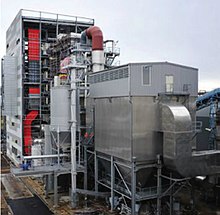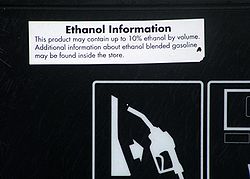From Wikipedia, the free encyclopedia

A cogeneration plant in Metz, France. The station uses waste wood biomass as an energy source, and provides electricity and heat for 30,000 dwellings.
Biomass is biological material derived from living, or recently living organisms. It most often refers to plants or plant-based materials which are specifically called lignocellulosic biomass.[1] As an energy source, biomass can either be used directly via combustion to produce heat, or indirectly after converting it to various forms of biofuel. Conversion of biomass to biofuel can be achieved by different methods which are broadly classified into: thermal, chemical, and biochemical methods.
Wood remains the largest biomass energy source to date;[2] examples include forest residues (such as dead trees, branches and tree stumps), yard clippings, wood chips and even municipal solid waste. In the second sense, biomass includes plant or animal matter that can be converted into fibers or other industrial chemicals, including biofuels. Industrial biomass can be grown from numerous types of plants, including miscanthus, switchgrass, hemp, corn, poplar, willow, sorghum, sugarcane, bamboo,[3] and a variety of tree species, ranging from eucalyptus to oil palm (palm oil).
Plant energy is produced by crops specifically grown for use as fuel that offer high biomass output per hectare with low input energy. Some examples of these plants are wheat, which typically yield 7.5–8 tonnes of grain per hectare, and straw, which typically yield 3.5–5 tonnes per hectare in the UK.[4] The grain can be used for liquid transportation fuels while the straw can be burned to produce heat or electricity. Plant biomass can also be degraded from cellulose to glucose through a series of chemical treatments, and the resulting sugar can then be used as a first generation biofuel.
Biomass can be converted to other usable forms of energy like methane gas or transportation fuels like ethanol and biodiesel. Rotting garbage, and agricultural and human waste, all release methane gas—also called "landfill gas" or "biogas." Crops, such as corn and sugar cane, can be fermented to produce the transportation fuel, ethanol. Biodiesel, another transportation fuel, can be produced from left-over food products like vegetable oils and animal fats.[5] Also, biomass to liquids (BTLs) and cellulosic ethanol are still under research.[6][7]
There is a great deal of research involving algal, or algae-derived, biomass due to the fact that it’s a non-food resource and can be produced at rates 5 to 10 times faster than other types of land-based agriculture, such as corn and soy. Once harvested, it can be fermented to produce biofuels such as ethanol, butanol, and methane, as well as biodiesel and hydrogen.
The biomass used for electricity generation varies by region. Forest by-products, such as wood residues, are common in the United States. Agricultural waste is common in Mauritius (sugar cane residue) and Southeast Asia (rice husks). Animal husbandry residues, such as poultry litter, are common in the UK.[8]
Biomass sources
Historically, humans have harnessed biomass-derived energy since the time when people began burning wood to make fire.[2] Even in today's modern era, biomass is the only source of fuel for domestic use in many developing countries. Biomass is all biologically-produced matter based in carbon, hydrogen and oxygen. The estimated biomass production in the world is 104.9 petagram (104.9 * 1015 g) of carbon per year, about half in the ocean and half on land.[9]
Wood remains the largest biomass energy source today;[2] examples include forest residues (such as dead trees, branches and tree stumps), yard clippings, wood chips and even municipal solid waste. Wood energy is derived by using lignocellulosic biomass (second generation biofuels) as fuel. This is either using harvested wood directly as a fuel, or collecting from wood waste streams. The largest source of energy from wood is pulping liquor or "black liquor," a waste product from processes of the pulp, paper and paperboard industry.[citation needed] In the second sense, biomass includes plant or animal matter that can be converted into fibers or other industrial chemicals, including biofuels. Industrial biomass can be grown from numerous types of plants, including miscanthus,[10] switchgrass, hemp, corn, poplar, willow, sorghum, sugarcane, bamboo,[3] and a variety of tree species, ranging from eucalyptus to oil palm (palm oil).
Based on the source of biomass, biofuels are classified broadly into two major categories. First generation biofuels are derived from sources such as sugarcane and corn starch etc. Sugars present in this biomass are fermented to produce bioethanol, an alcohol fuel which furthermore can be used directly in a fuel cell to produce electricity or serve as an additive to gasoline. However, utilizing food based resource for fuel production only aggravates the food shortage problem further.[11] Second generation biofuels on the other hand utilize non-food based biomass sources such as agriculture and municipal waste. It mostly consists of lignocellulosic biomass which is not edible and is a low value waste for many industries. Despite being the favored alternative, economical production of second generation biofuel is not yet achieved due to technological issues. These issues arise mainly due to chemical inertness and structural rigidity of lignocellulosic biomass.[12][13][14]
Plant energy is produced by crops specifically grown for use as fuel that offer high biomass output per hectare with low input energy. Some examples of these plants are wheat, which typically yield 7.5–8 tons (tonnes?) of grain per hectare, and straw, which typically yield 3.5–5 tons (tonnes?) per hectare in the UK.[4] The grain can be used for liquid transportation fuels while the straw can be burned to produce heat or electricity. Plant biomass can also be degraded from cellulose to glucose through a series of chemical treatments, and the resulting sugar can then be used as a first generation biofuel.
The main contributors of waste energy are municipal solid waste (MSW), manufacturing waste, and landfill gas. Energy derived from biomass is projected to be the largest non-hydroelectric renewable resource of electricity in the U.S between 2000 and 2020.[15]
Biomass can be converted to other usable forms of energy like methane gas or transportation fuels like ethanol and biodiesel. Rotting garbage, and agricultural and human waste, all release methane gas—also called "landfill gas" or "biogas." Crops, such as corn and sugar cane, can be fermented to produce the transportation fuel, ethanol. Biodiesel, another transportation fuel, can be produced from left-over food products like vegetable oils and animal fats.[5] Also, biomass to liquids (BTLs) and cellulosic ethanol are still under research.[6][7]
There is a great deal of research involving algae, or algae-derived, biomass due to the fact that it’s a non-food resource and can be produced at rates 5 to 10 times those of other types of land-based agriculture, such as corn and soy. Once harvested, it can be fermented to produce biofuels such as ethanol, butanol, and methane, as well as biodiesel and hydrogen. Efforts are being made to identify which species of algae are most suitable for energy production. Genetic engineering approaches could also be utilized to improve microalgae as a source of biofuel.[16]
The biomass used for electricity generation varies by region. Forest by-products, such as wood residues, are common in the United States. Agricultural waste is common in Mauritius (sugar cane residue) and Southeast Asia (rice husks). Animal husbandry residues, such as poultry litter, are common in the UK.[8]
As of 2015, a new bioenergy sewage treatment process aimed at developing countries is being trialed; the Omni Processor is a self-sustaining process which uses the sewerage solids as fuel in a process to convert the waste water into drinking water and with surplus electrical energy being generated for export.[17][18][19]
Comparison of total biomass yields (dry basis)
World Resources
If the total annual primary production of biomass is just over 100 billion (1.0E+11) tonnes /yr.[20] and the energy reserve per metric tonne of biomass is between about 1.5 – 3 Kilowatt hours (5000 – 10,000 BTU) [21] then biomass could perhaps provide only one tenth of the approximate annual 150 Terrawatt/hours required for the current world energy consumption[22]-
- (1.0E+11 tonnes biomass produced times either 1.5E+3 0E+3 watt hours)
- Annual world biomass energy income =15 – 30 Terrawatt/hours (1.5E+14 to 3.0E+14)
- Annual world energy consumption =150 Terrawatt/hours (1.5E+15 Watt/hours)
Second Generation Biofuels
Second-generation biofuels were not (in 2010) produced commercially, but a considerable number of research activities were taking place mainly in North America, Europe and also in some emerging countries. These tend to use feedstock produced by rapidly reproducing enzymes or bacteria from various sources including excrement[23] grown in Cell cultures or hydroponics[24][25]Common commodity food crops
- Agave: 1-21 tons/acre[26]
- Alfalfa: 4–6 tons/acre[27]
- Barley: grains – 1.6–2.8 tons/acre, straw – 0.9–2.5 tons/acre, total – 2.5–5.3 tons/acre[28]
- Canola: seeds –, stalks –, total –
- Corn: grains – 3.2–4.9 tons/acre, stalks and stovers – 2.3–3.4 tons/acre, total – 5.5–8.3 tons/acre[27]
- Jerusalem artichokes: tubers 1–8 tons/acre, tops 2–13 tons/acre, total 9–13 tons/acre[29]
- Oats: grains – 1.4–5.4 tons/acre, straw – 1.9–3.2 tons/acre, total – 3.3–8.6 tons/acre[28]
- Potatoes: tubers –, tops –, total –
- Rye: grains – 2.1–2.4 tons/acre, straw – 2.4–3.4 tons/acre, total – 4.5–5.8 tons/acre[28]
- Sorghum:
- Soybeans:
- Sugar beets:
- Sugar cane:
- Sun flowers:
- Sweet potatoes:
- Triticale:
- Wheat: grains – 1.2–4.1 tons/acre, straw – 1.6–3.8 tons/acre, total – 2.8–7.9 tons/acre[28]
Woody crops
- Coconuts:
- Gliricidia:
- Oil palm: frongs 11 ton/acre, whole fruit bunches 1 ton/acre, trunks 30 ton/acre[30]
- Pine:
- Poplar:
Not yet in commercial planting
- Energy beets
- Energy cane
- Giant miscanthus: 5–15 tons/acre [31]
- Sunn hemp: 4.5 tons/acre[32]
- Switchgrass: 4–6 tons/acre[27]
Genetically modified varieties
- Energy Sorghum
Biomass conversion process to useful energy
Thermal conversion
Trends in the top five countries generating electricity from biomass
Thermal conversion processes use heat as the dominant mechanism to convert biomass into another chemical form. The basic alternatives of combustion (torrefaction, pyrolysis, and gasification) are separated principally by the extent to which the chemical reactions involved are allowed to proceed (mainly controlled by the availability of oxygen and conversion temperature).
Energy created by burning biomass (fuel wood) is particularly suited for countries where the fuel wood grows more rapidly, e.g. tropical countries. There are a number of other less common, more experimental or proprietary thermal processes that may offer benefits such as hydrothermal upgrading (HTU) and hydroprocessing. Some have been developed for use on high moisture content biomass, including aqueous slurries, and allow them to be converted into more convenient forms. Some of the applications of thermal conversion are combined heat and power (CHP) and co-firing. In a typical dedicated biomass power plant, efficiencies range from 7–27% (HHV basis).[33] Biomass cofiring with coal, by contrast, typically occurs at efficiencies near those of the coal combustor (30–40%, HHV basis).[34]
Chemical conversion
A range of chemical processes may be used to convert biomass into other forms, such as to produce a fuel that is more conveniently used, transported or stored, or to exploit some property of the process itself. Many of these processes are based in large part on similar coal-based processes, such as Fischer-Tropsch synthesis, methanol production, olefins (ethylene and propylene), and similar chemical or fuel feedstocks. In most cases, the first step involves gasification, which step generally is the most expensive and involves the greatest technical risk.[35] Biomass is more difficult to feed into a pressure vessel than coal or any liquid. Therefore, biomass gasification is frequently done at atmospheric pressure and causes combustion of biomass to produce a combustible gas consisting of carbon monoxide, hydrogen, and traces of methane. This gas mixture, called a producer gas, can provide fuel for various vital processes, such as internal combustion engines, as well as substitute for furnace oil in direct heat applications.[36] Because any biomass material can undergo gasification, this process is far more attractive than ethanol or biomass production, where only particular biomass materials can be used to produce a fuel. In addition, biomass gasification is a desirable process due to the ease at which it can convert solid waste (such as wastes available on a farm) into producer gas, which is a very usable fuel.[36]Conversion of biomass to biofuel can also be achieved via selective conversion of individual components of biomass.[37] For example cellulose can be converted to intermediate platform chemical such a sorbitol,[38] glucose,[39] hydroxymethylfurfural[40] etc. These chemical are then further reacted to produce hydrogen or hydrocarbon fuels.[41]
Biomass also has the potential to be converted to multiple commodity chemicals. Halomethanes have successfully been by produced using a combination of A. fermentans and engineered S. cerevisiae.[42] This method converts NaX salts and unprocessed biomass such as switchgrass, sugar cane, corn stover, or poplar into halomethanes. S-adenosylmethionine which is naturally occurring in S. cerevisiae allows a methyl group to be transferred. Production levels of 150 mg L-1H-1 iodomethane were achieved. At these levels roughly 173000L of capacity would need to be operated just to replace the United States’ need for iodomethane.[42] However, an advantage of this method is that it uses NaI rather than I2; NaI is significantly less hazardous than I2. This method may be applied to produce ethylene in the future.
Other chemical processes such as converting straight and waste vegetable oils into biodiesel is transesterification.[43]
Biochemical conversion
As biomass is a natural material, many highly efficient biochemical processes have developed in nature to break down the molecules of which biomass is composed, and many of these biochemical conversion processes can be harnessed.Biochemical conversion makes use of the enzymes of bacteria and other microorganisms to break down biomass. In most cases, microorganisms are used to perform the conversion process: anaerobic digestion, fermentation, and composting.
In the United States
The biomass power generating industry in the United States, which consists of approximately 11,000 MW of summer operating capacity actively supplying power to the grid, produces about 1.4 percent of the U.S. electricity supply.[44]Currently, the New Hope Power Partnership is the largest biomass power plant in North America. The 140 MW facility uses sugar cane fiber (bagasse) and recycled urban wood as fuel to generate enough power for its large milling and refining operations as well as to supply electricity for nearly 60,000 homes.[45][46]
Environmental impact
Using biomass as a fuel produces air pollution in the form of carbon monoxide, carbon dioxide, NOx (nitrogen oxides), VOCs (volatile organic compounds), particulates and other pollutants at levels above those from traditional fuel sources such as coal or natural gas in some cases (such as with indoor heating and cooking).[47][48][49] Utilization of wood biomass as a fuel can also produce fewer particulate and other pollutants than open burning as seen in wildfires or direct heat applications.[50] Black carbon – a pollutant created by combustion of fossil fuels, biofuels, and biomass – is possibly the second largest contributor to global warming.[51] In 2009 a Swedish study of the giant brown haze that periodically covers large areas in South Asia determined that it had been principally produced by biomass burning, and to a lesser extent by fossil-fuel burning.[52] Researchers measured a significant concentration of 14C, which is associated with recent plant life rather than with fossil fuels.[53]Biomass power plant size is often driven by biomass availability in close proximity as transport costs of the (bulky) fuel play a key factor in the plant's economics. It has to be noted, however, that rail and especially shipping on waterways can reduce transport costs significantly, which has led to a global biomass market.[54] To make small plants of 1 MWel economically profitable those power plants have need to be equipped with technology that is able to convert biomass to useful electricity with high efficiency such as ORC technology, a cycle similar to the water steam power process just with an organic working medium. Such small power plants can be found in Europe.[55][56][57][58]
On combustion, the carbon from biomass is released into the atmosphere as carbon dioxide (CO2). The amount of carbon stored in dry wood is approximately 50% by weight.[59] However, according to the Food and Agriculture Organization of the United Nations, plant matter used as a fuel can be replaced by planting for new growth. When the biomass is from forests, the time to recapture the carbon stored is generally longer, and the carbon storage capacity of the forest may be reduced overall if destructive forestry techniques are employed.[60][61][62][63]
Industry professionals claim that a range of issues can affect a plant's ability to comply with emissions standards. Some of these challenges, unique to biomass plants, include inconsistent fuel supplies and age. The type and amount of the fuel supply is completely reliant factors; the fuel can be in the form of building debris or agricultural waste (such as deforestation of invasive species or orchard trimmings). Furthermore, many of the biomass plants are old, use outdated technology and were not built to comply with today’s stringent standards. In fact, many are based on technologies developed during the term of U.S. President Jimmy Carter, who created the United States Department of Energy in 1977.[2]
The U.S. Energy Information Administration projected that by 2017, biomass is expected to be about twice as expensive as natural gas, slightly more expensive than nuclear power, and much less expensive than solar panels.[64] In another EIA study released, concerning the government’s plan to implement a 25% renewable energy standard by 2025, the agency assumed that 598 million tons of biomass would be available, accounting for 12% of the renewable energy in the plan.[65]
The adoption of biomass-based energy plants has been a slow but steady process. Between the years of 2002 and 2012 the production of these plants has increased 14%.[66] In the United States, alternative electricity-production sources on the whole generate about 13% of power; of this fraction, biomass contributes approximately 11% of the alternative production.[67] According to a study conducted in early 2012, of the 107 operating biomass plants in the United States, 85 have been cited by federal or state regulators for the violation of clean air or water standards laws over the past 5 years. This data also includes minor infractions.[66]
Despite harvesting, biomass crops may sequester carbon. For example, soil organic carbon has been observed to be greater in switchgrass stands than in cultivated cropland soil, especially at depths below 12 inches.[68] The grass sequesters the carbon in its increased root biomass. Typically, perennial crops sequester much more carbon than annual crops due to much greater non-harvested living biomass, both living and dead, built up over years, and much less soil disruption in cultivation.
The proposal that biomass is carbon-neutral put forward in the early 1990s has been superseded by more recent science that recognizes that mature, intact forests sequester carbon more effectively than cut-over areas. When a tree's carbon is released into the atmosphere in a single pulse, it contributes to climate change much more than woodland timber rotting slowly over decades. Current studies indicate that "even after 50 years the forest has not recovered to its initial carbon storage" and "the optimal strategy is likely to be protection of the standing forest".[69][not in citation given][70][71]
The pros and cons of biomass usage regarding carbon emissions may be quantified with the ILUC factor. There is controversy surrounding the usage of the ILUC factor.[72]
Forest-based biomass has recently come under fire from a number of environmental organizations, including Greenpeace and the Natural Resources Defense Council, for the harmful impacts it can have on forests and the climate. Greenpeace recently released a report entitled "Fuelling a BioMess"[73] which outlines their concerns around forest-based biomass. Because any part of the tree can be burned, the harvesting of trees for energy production encourages Whole-Tree Harvesting, which removes more nutrients and soil cover than regular harvesting, and can be harmful to the long-term health of the forest. In some jurisdictions, forest biomass removal is increasingly involving elements essential to functioning forest ecosystems, including standing trees, naturally disturbed forests and remains of traditional logging operations that were previously left in the forest. Environmental groups also cite recent scientific research which has found that it can take many decades for the carbon released by burning biomass to be recaptured by regrowing trees, and even longer in low productivity areas; furthermore, logging operations may disturb forest soils and cause them to release stored carbon.[citation needed] In light of the pressing need to reduce greenhouse gas emissions in the short term in order to mitigate the effects of climate change, a number of environmental groups are opposing the large-scale use of forest biomass in energy production.[74][75]
Supply chain issues
With the seasonality of biomass supply and a great variability in sources, supply chains play a key role in cost-effective delivery of bioenergy. There are several potential challenges peculiar to bioenergy supply chains:[76]Technical and technological issues
- Inefficiencies of conversion
- Infeasibility of large-scale production due to environmental concerns
- Conflicting decisions (technologies, locations, and routes)
- Complex location analysis (source points, inventory facilities, and production plants)
- The limits for the economy of scale
- Unavailability and complexity of life cycle costing data
- Lack of required transport infrastructure
- Limited flexibility or inflexibility to energy demand
- Risks associated with new technologies (insurability, performance, rate of return)
- Extended market volatilities (conflicts with alternative markets for biomass)
- Lack of participatory decision making
- Lack of public/community awareness
- Local supply chain impacts vs. global benefits
- Health and safety risks
- Extra pressure on transport sector
- Decreasing the esthetics of rural areas
- Impact of fossil fuel tax on biomass transport
- Lack of incentives to create competition among bioenergy producers
- Focus on technology options and less attention to selection of biomass materials
- Lack of support for sustainable supply chain solutions
- Varied ownership arrangements and priorities among supply chain parties
- Lack of supply chain standards
- Impact of organizational norms and rules on decision making and supply chain coordination
- Immaturity of change management practices in biomass supply chains











